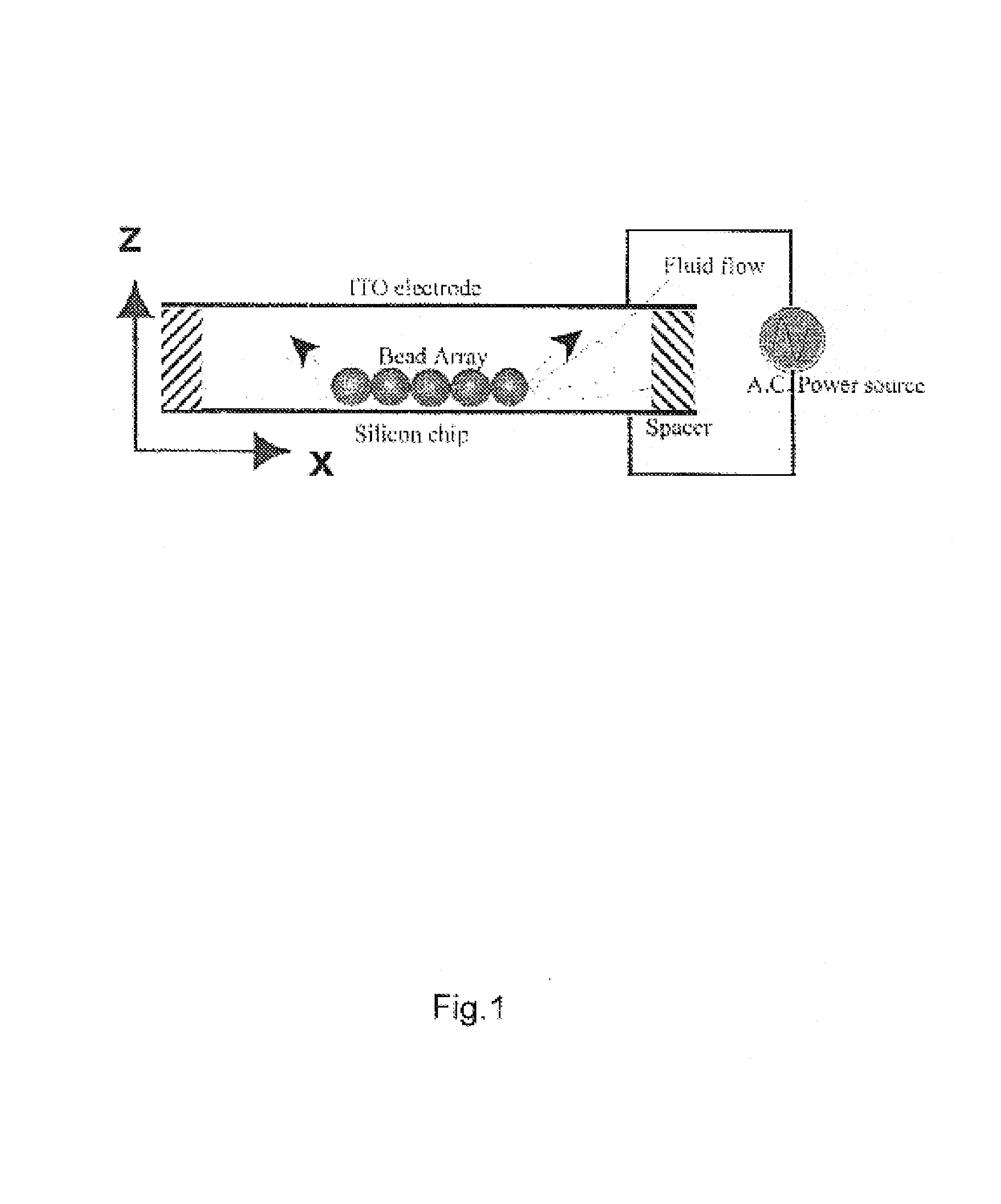Directed assembly of functional heterostructures
a functional heterostructure and heterostructure technology, applied in the direction of electrolysis, isotope separation, immobilised enzymes, etc., can solve the problems of labor-intensive and difficult gel-matrix formation for the assay, slow reported assembly of 3d arrays, and considerable technological challenges, so as to reduce the temperature of the gellable component, simple to implement and flexible
- Summary
- Abstract
- Description
- Claims
- Application Information
AI Technical Summary
Problems solved by technology
Method used
Image
Examples
example 1
AC Electric Field-Mediated Formation of Patterned Gel Films
[0092]LEAPS is carried out in a fluidic microcell formed by sandwiching a double-sided Kapton spacer of ˜100 μm thickness (between a 1 cm×1 cm silicon chip, n-type, capped either by a uniform or a lithographically patterned thin SiO2 layer), also serving as the bottom electrode, and a glass cover slip coated with indium tin oxide (ITO) to a typical sheet resistance of 1400 Ohm Square serving as the top electrode. FIG. 1 illustrates the various components of a LEAPS microcell.
[0093]The mixture of monomers and the initiator is introduced within the LEAPS cell and the electric field is applied. The thermal free radical polymerization is then initiated by heating the cell ˜40–45° C. using an IR lamp (the polymerization can also be triggered by a step change in the bias voltage from a large positive value to a small positive value). Typical parameters of the AC electric field used for this particular example are Vp-p˜5–8V and ω˜1...
example 2
Preparation of Gel-Microparticle Hybrid Films
[0096]A two stage process is used to synthesize polymer-microparticle composites. First, ordered particle arrays are formed from a microparticle suspension that also contains all of the ingredients required for subsequent in-situ gel formation in accordance with Example 1. LEAPS (see Example 1) is used to form arrays from particles suspended in a low viscosity dispersion of monomer(s) mixed with an initiator in accordance with Example 1. Second, gels are formed, either via heat-initiated in-situ polymerization (Example 1) to form spatially patterned hybrid gels (see FIG. 3(a)) or via UV-initiated in-situ polymerization to form monolithic hybrid gels (see FIG. 3(b)), as described below.
[0097]To assemble particle arrays, an AC voltage chosen in the range of 1–20 Vp-p, with a frequency in the range of 100 Hz to several kilohertz is applied between the electrodes across the fluid gap. Fluid and particle transport and assembly are then monitor...
example 3
Self-Supporting Magnetic Gel Films
[0100]In one embodiment, free standing gel microparticle hybrid films similar to those described in the detailed description section are prepared according to the invention using functionalized and superparamagnetic microparticles or a mixture of superparamagnetic particles with (non-magnetic) color-encoded and functionalized microparticles. Incorporation of magnetically responsive particles permits the separation of the gel film from a solution containing a biological sample or samples by application of a magnetic field.
[0101]This is of particular benefit in carrying out multi-step biological assay protocols.
[0102]In a protocol involving the self supporting magnetic gel films of this invention (FIG. 9a), an in-tube binding assay that probes analyte molecules in solution through their capture by receptors on beads is performed under conditions permitting the magnetic gel-microparticle film to remain in suspension (FIG. 9b). Following completion of t...
PUM
| Property | Measurement | Unit |
|---|---|---|
| thickness | aaaaa | aaaaa |
| thickness | aaaaa | aaaaa |
| thickness | aaaaa | aaaaa |
Abstract
Description
Claims
Application Information
 Login to View More
Login to View More - R&D
- Intellectual Property
- Life Sciences
- Materials
- Tech Scout
- Unparalleled Data Quality
- Higher Quality Content
- 60% Fewer Hallucinations
Browse by: Latest US Patents, China's latest patents, Technical Efficacy Thesaurus, Application Domain, Technology Topic, Popular Technical Reports.
© 2025 PatSnap. All rights reserved.Legal|Privacy policy|Modern Slavery Act Transparency Statement|Sitemap|About US| Contact US: help@patsnap.com



